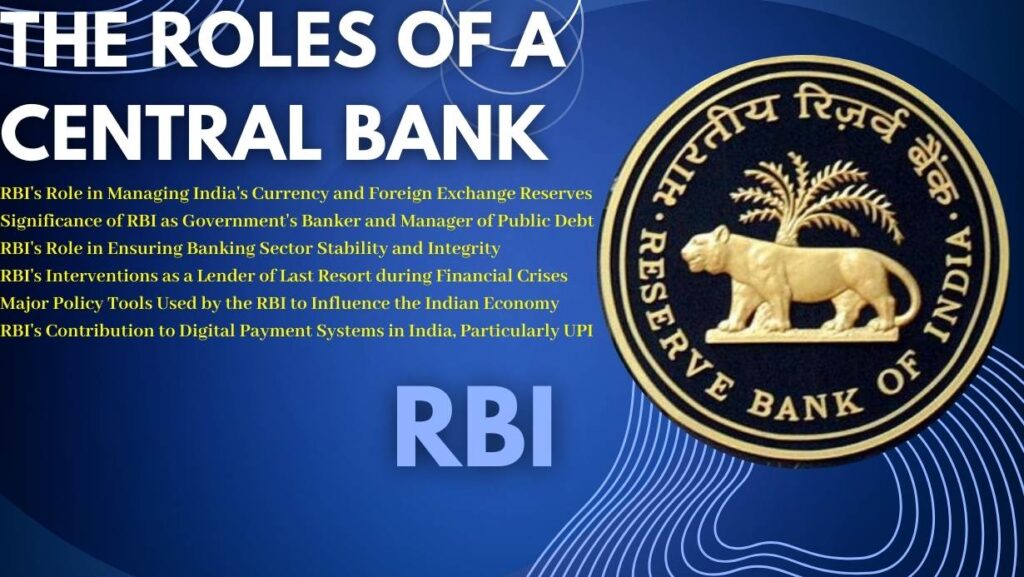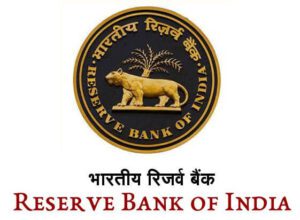Central banks play a pivotal role in shaping the economic stability and financial well-being of a nation. They are the cornerstone of a country’s monetary and financial system, and their functions are critical in achieving economic goals. One such central bank that stands as a prominent example is the Reserve Bank of India (RBI). In this article, we will delve into the essential roles of a central bank and explore how the RBI has fulfilled these roles to influence the Indian economy.

The Roles of a Central Bank
Central banks worldwide perform several key functions to ensure economic stability and growth. These roles include:

Monetary Policy Formulation by Central Bank :
Central banks are responsible for setting and implementing monetary policies to control inflation, maintain price stability, and promote economic growth. They achieve this through instruments like interest rates and open market operations. In India, the RBI plays a crucial role in formulating and executing monetary policies to keep inflation in check.
Currency Issuance and Management:
Central banks are the sole authority for issuing and regulating a nation’s currency. They ensure the adequacy of currency supply to meet public demand. The RBI takes charge of managing the Indian rupee, controlling its supply, and preventing counterfeit currency from entering circulation.
Bank Supervision and Regulation by the Central Bank:
Central banks supervise and regulate commercial banks and financial institutions to maintain the stability of the financial system. They establish and enforce prudential norms, monitor banks’ activities, and intervene when necessary to prevent systemic crises. The RBI supervises and regulates banks in India, ensuring their compliance with various regulations.
Foreign Exchange Management:
Central banks manage foreign exchange reserves to safeguard a nation’s economic interests. They intervene in currency markets to stabilize exchange rates and protect their economies from external shocks. The RBI maintains foreign exchange reserves and manages India’s external trade and payments.
Lender of Last Resort:
In times of financial distress, central banks act as lenders of last resort. They provide emergency liquidity assistance to banks facing solvency issues to prevent a financial collapse. The RBI has played this role during banking crises in India, ensuring the stability of the financial system.
Government Banker and Debt Management:
Central banks act as bankers to the government, handling its accounts and transactions. They also manage government debt, issuing bonds and conducting debt auctions. The RBI serves as the government’s banker and manages government securities in India.
Payment System Oversight:
Central banks oversee and facilitate the smooth functioning of payment systems within their jurisdiction. They develop and operate payment and settlement systems, ensuring the efficient transfer of funds. The RBI has introduced various payment systems and digital initiatives, like UPI (Unified Payments Interface), to enhance India’s payment infrastructure.
The Reserve Bank of India in Action
The Reserve Bank of India (RBI), established on April 1, 1935, as India’s central bank, has been diligently fulfilling these roles to influence the Indian economy positively. Here are a few examples of how the RBI operates in each of these key areas:
Monetary Policy Formulation:
The RBI employs various tools, including the repo rate and reverse repo rate, to regulate the money supply in India. It adjusts these rates to control inflation and encourage or discourage borrowing and spending, thereby affecting economic activity.
Currency Issuance and Management:
The RBI is responsible for issuing and regulating Indian currency. It also manages currency distribution through a vast network of banks and ATMs across the country.
Bank Supervision and Regulation:
The RBI conducts regular inspections and audits of banks to ensure their financial soundness. It imposes penalties and corrective measures when necessary to maintain the stability and integrity of the banking sector.
Foreign Exchange Management:
The RBI actively manages India’s foreign exchange reserves, using them to stabilize the rupee’s exchange rate and safeguard against external economic shocks.
Lender of Last Resort:
During the global financial crisis of 2008 and subsequent banking crises in India, the RBI provided financial support to banks facing liquidity problems, preventing systemic collapses.
Government Banker and Debt Management:
The RBI manages the government’s accounts and assists in raising funds through bond auctions. It plays a crucial role in facilitating government transactions and managing public debt.
Payment System Oversight:
The RBI introduced the Unified Payments Interface (UPI) in 2016, revolutionizing digital payments in India. UPI has since become a widely used and convenient method for individuals and businesses to transfer funds.
Conclusion
The central bank, exemplified by the Reserve Bank of India, serves as the backbone of a nation’s monetary and financial system. Its multifaceted roles encompass monetary policy, currency issuance, bank supervision, foreign exchange management, financial stability, and much more. By effectively carrying out these functions, central banks contribute to economic stability, growth, and overall well-being.
In the case of India, the Reserve Bank of India’s proactive measures, innovative policies, and commitment to financial stability have played a pivotal role in steering the country’s economic course. As the global economic landscape continues to evolve, the role of central banks like the RBI remains indispensable in guiding nations toward prosperity and resilience.
Role of the Reserve Bank of India (RBI):
The Reserve Bank of India (RBI) is the central banking institution in India, responsible for regulating and controlling the monetary and financial systems of the country. Its primary roles include issuing currency, formulating and implementing monetary policy, managing foreign exchange reserves, supervising the banking sector, and acting as the government’s banker and debt manager.
RBI’s Contribution to Controlling Inflation in India:
The RBI controls inflation through monetary policy tools like repo rate, reverse repo rate, cash reserve ratio (CRR), and statutory liquidity ratio (SLR). By adjusting these rates, the RBI influences borrowing costs, money supply, and liquidity in the economy, thereby managing inflationary pressures.
Key Functions of a Central Bank and RBI’s Fulfillment:
Key functions of a central bank include monetary policy, currency issuance, regulation and supervision of banks, management of foreign exchange reserves, and acting as a banker to the government. The RBI fulfills these functions through its various departments and policies.
RBI’s Role in Managing India’s Currency and Foreign Exchange Reserves:
The RBI is responsible for issuing and managing the Indian Rupee (currency). It also manages foreign exchange reserves to ensure stability in external trade and investments, maintain exchange rate stability, and meet international payment obligations.
Significance of RBI as Government’s Banker and Manager of Public Debt:
Acting as the government’s banker, the RBI handles the government’s accounts, transactions, and manages public debt issuance. This ensures smooth financial operations of the government and effective debt management.
RBI’s Role in Ensuring Banking Sector Stability and Integrity:
The RBI supervises and regulates banks to maintain the stability and integrity of the banking sector. It sets prudential norms, conducts inspections, and enforces regulations to ensure sound financial health and ethical conduct within the banking industry.
RBI’s Interventions as a Lender of Last Resort during Financial Crises:
The RBI acts as a lender of last resort by providing liquidity and financial support to banks and financial institutions during crises. For example, during the global financial crisis in 2008, the RBI implemented measures like reducing interest rates and injecting liquidity to stabilize the financial system.
Major Policy Tools Used by the RBI to Influence the Indian Economy:
The RBI employs various policy tools, including the repo rate, reverse repo rate, CRR, SLR, open market operations (OMOs), and qualitative measures, to influence the economy, manage inflation, encourage growth, and maintain financial stability.
RBI’s Contribution to Digital Payment Systems in India, Particularly UPI:
The RBI has played a pivotal role in the development and promotion of digital payment systems in India, notably the Unified Payments Interface (UPI). UPI facilitates instant fund transfers and has significantly enhanced digital transactions, promoting a cashless economy.
Comparison of RBI’s Role to Central Banks in Other Countries:
The RBI’s role is similar to other central banks in terms of monetary policy, regulation, and supervision of the banking sector. However, each central bank adapts its strategies based on the economic and financial environment of its respective country, leading to differences in operational approaches and policies
Don’t Miss Out on Our Other Blog Posts
Credit Monitoring
aeps
PMSBY
